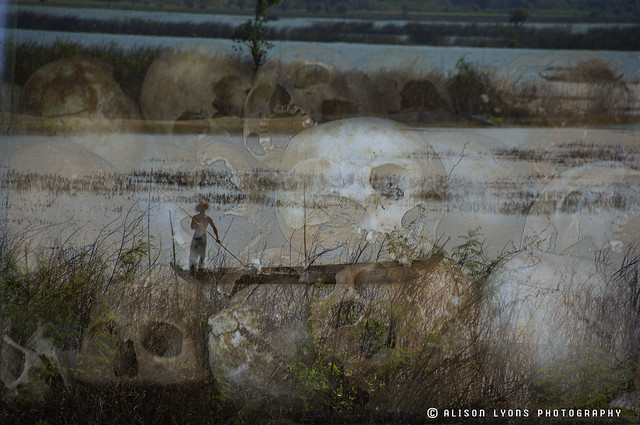I don’t normally take audio tours when I visit places. I like to do my own research and visit at my own pace. I’m not really one for rules or too much structure. But upon entering the Choeung Ek site... the Killing Fields, I was automatically handed a headset and audio player, and so it was a done deal. The narrative began with eloquent words to an underscore of peaceful classical music.
It was warm and sunny and at first it was difficult to comprehend what at had taken place here. But the audio tour drew us in and led us gently along peaceful paths to places that had such a violent and hideous history. The serenity of the location made it almost impossible to accept that these atrocities had actually taken place here, despite the clear evidence of clothing and bone fragments and obvious burial mounds.
I wanted to be here, as it was a far cry from sipping cocktails on the third floor balcony of the Foreign Correspondents Club, where we spent the previous evening. This is where history actually took place. This would become a backdrop and frame of reference for the remainder of our visit to Cambodia... and this was confronting.
Choeng Ek is the site of a former orchard and Chinese graveyard about 17km south of Phnom Penh. Between 1975 and 1979, the Khmer Rouge executed about 17,000 people at the Killing Fields. Under Pol Pot’s “leadership” Cambodians killed Cambodians. Here at Choeng Ek, nearly 9,000 bodies were discovered in mass graves. Human bones and remnants of clothing still litter the site.
As a policy, bullets were not to be wasted, so the people were beaten to death, poisoned or buried alive, often having dug their own mass burial pits.
We walk around the site, detached, seeking refuge from the heat under the cool shade of the trees. By listening to the headsets, we each make our own solitary journey, no-one talks, everyone listens. I observe other tourists, headsets in place, sitting under a tree, lost in thought and faces sombre, we all reflect on what we are hearing.
I was 18 when these atrocities took place. Attending art school, meeting boys, gaining an education and attending parties. I had no idea.
...and the rest of the world stood still.
The Killing Fields
Subscribe to:
Post Comments (Atom)

No comments:
Post a Comment